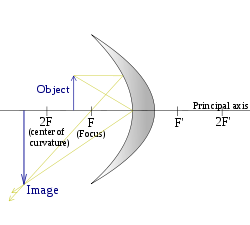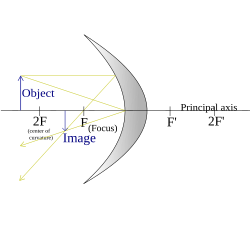Concave mirror
A concave mirror is a concave (inward) curved mirror ( concave mirror ). In particular, concave mirrors in the form of a spherical section (“ spherical ” mirror) and in the form of paraboloids of rotation are used in practice .
A concave mirror that is used to concentrate rays at its focal point (focus) (e.g. sun rays when using solar energy in solar power plants ) is called a burning mirror .
history
The French doctor Pierre Borel , member of the Paris Académie des Sciences , used the concave mirror as an examination instrument in the 17th century. For the purpose of medical examinations and better illumination of body openings, he constructed a concave mirror to reflect and focus the light on the object to be examined. Slightly modified, concave mirrors are still used today as forehead mirrors or reflectors in medical diagnostics.
For earlier descriptions of the concave mirror, see also Archimedes - Brennspiegel , Alhazen (there in particular on Alhazen's problem ) and Schatz der Optik (there in particular the illustration on the title page).
Two main variations
Analogous to spherical and aspherical converging lenses, there are also two designs for concave mirrors. The more complex and expensive design has the advantage of largely suppressing the spherical aberration .
Parabolic mirror
Only with the parabolic mirror are all the light rays incident parallel to the optical axis bundled exactly in the focal point (focus). The parabolic shape, however, is somewhat more complex to manufacture than the spherical shape.
Spherical concave mirror
A parabolic mirror can be approximated for small angles of curvature by means of a spherical surface, with an accuracy that is sufficient for many applications. A spherical mirror is much easier to manufacture than a parabolic mirror, so it is often preferred.
The optical property of the concave mirror is determined by the radius of the sphere, the wall segment of which it represents, the so-called radius of curvature. If you place an (imaginary) point light source in the center of the sphere , the mirror reflects the light from the source back onto it. If the light rays come parallel from infinity , the mirror reflects them to the focus (focal point). This is roughly halfway between the center and the mirror. The focal length of a concave mirror is half its circle radius. However, due to the spherical aberration , the combination of the light rays is only imperfect there: the light rays form a figure known as catac acoustics near the focus . (In contrast, this is avoided with the parabolic mirror.)
Optical illustration
The considerations are made under the assumption that they take place in an angular range where the spherical and parabolic mirrors behave approximately the same.
If you look into a concave mirror within the focal length, i.e. between the mirror and the focal point, you see yourself enlarged , whereby the image is upright and laterally reversed , like in a plane mirror . If you look into a concave mirror from outside the focal point, the reflected image is upside down. The image generated by a concave mirror can be calculated using the law of reflection (see also: optical imaging ).
Concave mirrors are used, among other things, as main mirrors in mirror telescopes , in optical spectrometers and monochromators, and as shaving mirrors . The satellite dishes for television reception or radar antennas also work on the same principle, but for the radio waves related to light.
Beam paths at different object distances
Similar to the convex lens , a virtual image is created when the object distance is smaller than the focal length (see magnifying glass ). A typical example is the cosmetic mirror , which has only a slight curvature and thus a large focal length. The focal length is therefore greater than the distance between the observer (who in this case is the object) and the mirror.
The magnification compared to a plane mirror with the same viewing distance is a maximum of 2 times (both mirrors at a distance of the focal length of the concave mirror). However, if the plane mirror is positioned so close that the mirror image can just be seen clearly, the concave mirror at a distance increases by the factor . This magnification can be increased slightly by reducing the distance to the concave mirror.
The shape of the mirror is variable, with concave mirrors it is usually round, with a normal mirror often embedded on the back . The cosmetic mirror usually also has a frame so that it can be placed upright or hung up.
In the case of object distances greater than the focal length, an inverted real image generally arises, also similar to the convex lens (exception: object distance equals the focal length; see below). The magnification depends on the ratio of the object distance to the focal length. An example is the telescope mirror, in which the object distance is very large and a greatly reduced image is created near the focal plane (in order for a star to fit on a photo plate, it must be extremely reduced).
|
Object distance ( G ), focal length ( F ) |
image | Beam path |
|---|---|---|
|
(Object between mirror and focal point) |
|

|
|
(Object is in the focal plane ) |
|

|
|
(Object is between the single and double focal length) |
|

|
|
(the object distance corresponds to twice the focal length) |
|

|
|
(the object distance is greater than twice the focal length) |
|

|
Others
In the magazine Der Spiegel there is a column on the penultimate page with the title Concave Mirror . There are funny, curious or involuntarily comical newspaper clippings, newspaper headlines, advertisements , clippings from operating instructions, etc. quoted.
See also
Web links
Individual evidence
- ↑ Burning mirror. In: Lexicon of Physics. Spektrum Akademischer Verlag, Heidelberg 1998 ( online ).
- ↑ Nezhat's History of Endoscopy, Chapter 3 HTML version , PDF version ( Memento of the original from October 7, 2013 in the Internet Archive ) Info: The archive link was inserted automatically and has not yet been checked. Please check the original and archive link according to the instructions and then remove this notice.
- ↑ J. Hattenbach: The enlargement of one's own reflection in the cosmetic mirror
- ↑ Concave mirror - The best finds. Heyne-Verlag, Munich 2010, ISBN 978-3-453-60164-2 .
- ↑ Best of concave mirror 2008. at Spiegel-Online









